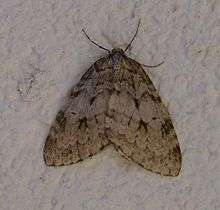Pale November moth
| Pale November moth | |
|---|---|
 | |
| Mounted | |
 | |
| Live adult | |
| Scientific classification | |
| Kingdom: | Animalia |
| Phylum: | Arthropoda |
| Class: | Insecta |
| Order: | Lepidoptera |
| Family: | Geometridae |
| Genus: | Epirrita |
| Species: | E. christyi |
| Binomial name | |
| Epirrita christyi Allen, 1906 | |
The pale November moth (Epirrita christyi) is a moth of the family Geometridae. It is a fairly common species in Western Europe including the British Isles.

Caterpillar
This species is almost identical to its relatives the November moth and autumnal moth and it is almost impossible to identify them without examination of the genitalia. In general, although melanism occurs regularly in this species it is less prevalent than in the November moth. The pale November moth flies at night from September to November and is attracted to light.
The larva feeds on a variety of trees and shrubs (see list below). The species overwinters as an egg.
- ^ The flight season refers to the British Isles. This may vary in other parts of the range.
Recorded food plants
- Acer - maple
- Betula - birch
- Corylus - hazel
- Crataegus - hawthorn
- Fagus - beech
- Prunus
- Quercus - oak
- Sorbus
- Ulmus - elm
References
- Chinery, Michael Collins Guide to the Insects of Britain and Western Europe 1986 (Reprinted 1991)
- Skinner, Bernard Colour Identification Guide to the Moths of the British Isles 1984
External links
- European Butterflies and Moths
- Lepidoptera of Belgium
- Lepiforum.de
- Vlindernet (Dutch)
- waarneming.nl (Dutch)
This article is issued from Wikipedia - version of the 4/2/2015. The text is available under the Creative Commons Attribution/Share Alike but additional terms may apply for the media files.